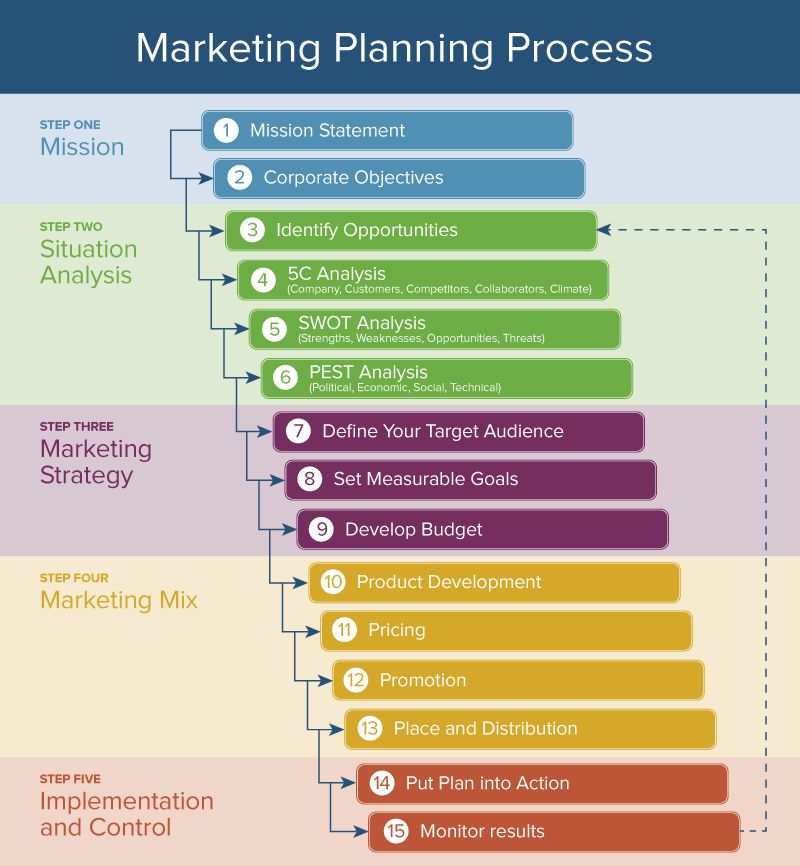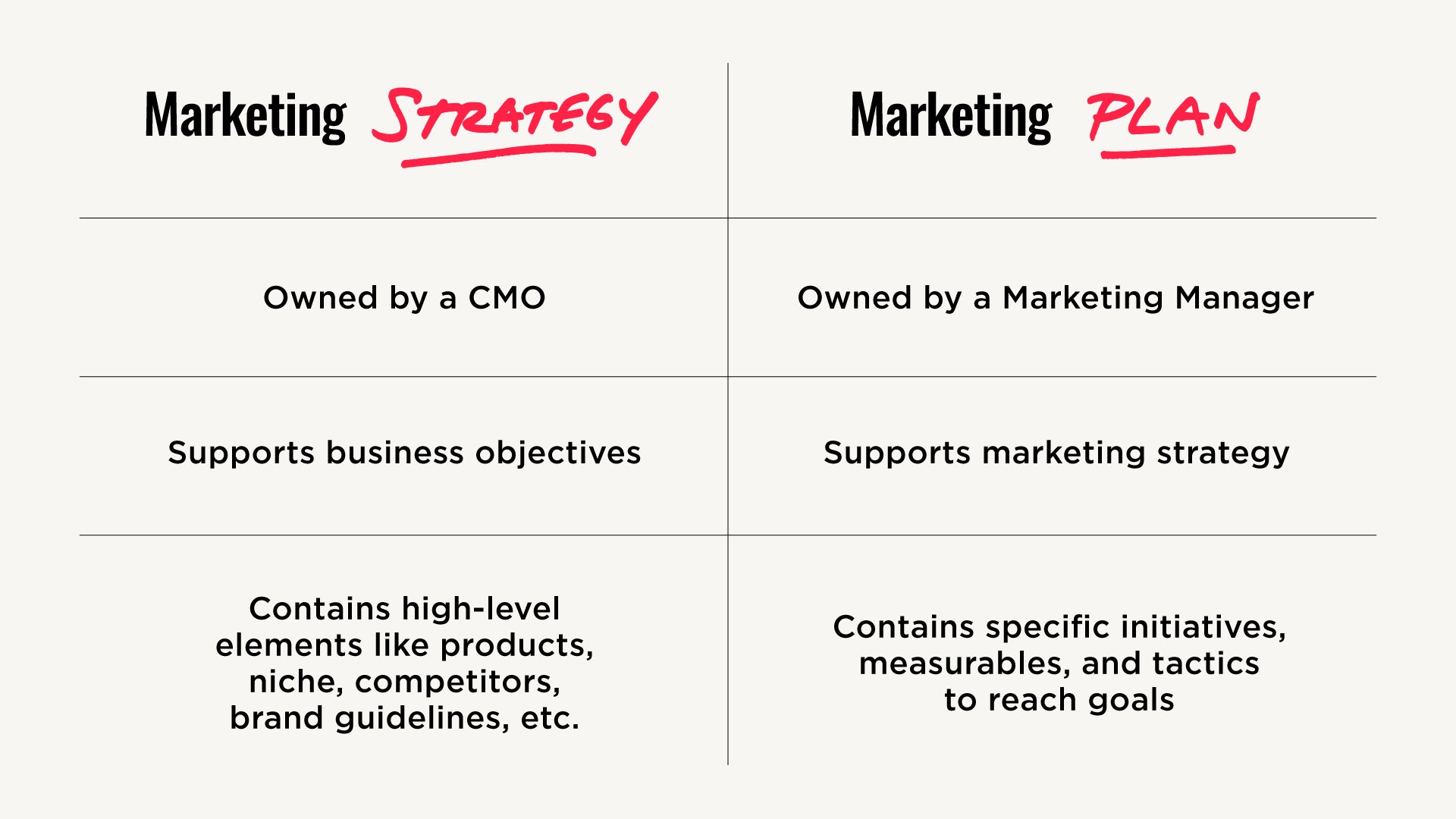- What is the Difference Between a Marketing Plan and a Marketing Strategy?
- What is the difference between a plan and a strategy?
- What is the difference between a go-to-market strategy and a marketing plan?
- What comes first, a marketing plan or strategy?
- What is the difference between strategic and marketing planning?
- Frequently Asked Questions from Our Community
Understanding the distinction between a marketing plan and a marketing strategy is essential for businesses aiming to achieve their goals effectively. While these terms are often used interchangeably, they serve different purposes in the marketing process. A marketing strategy outlines the overarching approach to reaching target audiences and achieving long-term objectives, focusing on the why and what of marketing efforts. In contrast, a marketing plan is a detailed roadmap that specifies the how, including tactics, timelines, and budgets. By clarifying these differences, businesses can align their vision with actionable steps, ensuring a cohesive and results-driven approach to their marketing endeavors.
https://youtube.com/watch?v=UU2Uia8Pzw8
See Also Best Tradeshow Booth Vendors/Resources?
Best Tradeshow Booth Vendors/Resources?What is the Difference Between a Marketing Plan and a Marketing Strategy?
A marketing strategy and a marketing plan are two essential components of a business's marketing efforts, but they serve different purposes. A marketing strategy is the overarching approach or blueprint that outlines how a business will achieve its marketing goals. It focuses on the why and what of marketing, such as identifying target audiences, value propositions, and competitive advantages. On the other hand, a marketing plan is a detailed document that specifies the how, when, and where of executing the strategy. It includes actionable steps, timelines, budgets, and specific tactics to implement the strategy effectively.
1. What is a Marketing Strategy?
A marketing strategy is a long-term plan designed to achieve specific business objectives, such as increasing brand awareness, entering new markets, or boosting sales. It involves analyzing the market, understanding customer needs, and identifying unique selling points. The strategy provides direction and ensures all marketing efforts align with the company's overall goals. For example, a company might decide to focus on digital marketing to reach a younger audience or emphasize sustainability to attract eco-conscious consumers.
See Also 90 Real-World Examples of Made to Stick Principles
90 Real-World Examples of Made to Stick Principles2. What is a Marketing Plan?
A marketing plan is a tactical roadmap that outlines the steps needed to execute the marketing strategy. It includes specific actions, such as launching a social media campaign, creating content, or hosting events. The plan also details the resources required, timelines, and key performance indicators (KPIs) to measure success. For instance, a marketing plan might specify that a company will run a Google Ads campaign for three months with a budget of $10,000 to increase website traffic by 20%.
3. Key Differences Between a Marketing Strategy and a Marketing Plan
The main difference lies in their scope and purpose. A marketing strategy is broad and conceptual, focusing on the overall approach to achieving business goals. In contrast, a marketing plan is detailed and operational, focusing on the execution of the strategy. Below is a table summarizing the differences:
See Also How Different Is Customer Service Versus Marketing?
How Different Is Customer Service Versus Marketing?| Aspect | Marketing Strategy | Marketing Plan |
|---|---|---|
| Purpose | Defines the overall approach to achieve goals | Outlines specific actions to implement the strategy |
| Focus | Long-term vision and direction | Short-term execution and tactics |
| Components | Target audience, value proposition, competitive analysis | Campaigns, budgets, timelines, KPIs |
4. Why is a Marketing Strategy Important?
A marketing strategy is crucial because it provides a clear direction for all marketing activities. Without a strategy, businesses risk wasting resources on ineffective tactics or failing to differentiate themselves from competitors. A well-defined strategy ensures that marketing efforts are aligned with the company's goals and resonate with the target audience. For example, a luxury brand might focus on exclusivity and premium pricing as part of its strategy to attract high-end customers.
5. Why is a Marketing Plan Important?
A marketing plan is essential for translating the strategy into actionable steps. It ensures that all team members understand their roles and responsibilities and that resources are allocated efficiently. A detailed plan also allows businesses to track progress and make adjustments as needed. For instance, if a social media campaign is not generating the expected engagement, the plan can be revised to include different content formats or platforms.
See Also Here's How Social Media Algorithms Work:
Here's How Social Media Algorithms Work:What is the difference between a plan and a strategy?

Definition of a Plan
A plan is a detailed proposal for achieving specific goals or objectives. It outlines the steps, resources, and timeline required to accomplish a task or project. Plans are often more tactical and focus on the how of execution.
- Specificity: Plans are detailed and include step-by-step instructions.
- Short-term focus: They are usually designed for immediate or near-future actions.
- Flexibility: Plans can be adjusted as circumstances change.
Definition of a Strategy
A strategy is a high-level approach designed to achieve long-term goals. It involves making choices about where to compete and how to win, often considering external factors like competition and market conditions.
- Broad scope: Strategies cover a wide range of activities and decisions.
- Long-term focus: They are designed to achieve objectives over an extended period.
- Adaptability: Strategies are flexible to respond to changing environments.
Key Differences in Focus
The primary difference between a plan and a strategy lies in their focus. A plan is more about the immediate steps needed to achieve a goal, while a strategy is about the overarching approach to achieving long-term success.
- Immediate vs. Long-term: Plans are for short-term execution; strategies are for long-term vision.
- Detail vs. Big Picture: Plans are detailed; strategies are broad and conceptual.
- Execution vs. Direction: Plans focus on execution; strategies focus on setting direction.
Differences in Application
In application, a plan is often used to implement a strategy. The strategy sets the direction, and the plan provides the roadmap to follow that direction.
- Implementation: Plans are used to execute strategies.
- Resource Allocation: Plans detail resource use; strategies guide where resources should be allocated.
- Measurement: Plans include specific metrics for success; strategies define what success looks like.
Examples in Business Context
In a business context, a strategy might involve entering a new market, while the plan would detail the steps needed to achieve that, such as market research, product development, and marketing campaigns.
- Market Entry: Strategy decides to enter a new market; the plan outlines how to do it.
- Product Launch: Strategy focuses on the product's positioning; the plan details the launch process.
- Competitive Advantage: Strategy identifies the unique value proposition; the plan implements it.
What is the difference between a go-to-market strategy and a marketing plan?

What is a Go-To-Market Strategy?
A go-to-market (GTM) strategy is a comprehensive plan that outlines how a company will deliver its product or service to the market and achieve a competitive advantage. It focuses on the entire process from product development to customer acquisition, ensuring alignment across all departments. Key elements include:
- Target Audience: Identifying the specific customer segments to focus on.
- Value Proposition: Defining the unique benefits the product offers.
- Distribution Channels: Deciding how the product will reach customers (e.g., online, retail).
- Pricing Strategy: Setting competitive and profitable pricing.
- Launch Plan: Coordinating the timing and execution of the product release.
What is a Marketing Plan?
A marketing plan is a detailed roadmap that outlines how a company will promote its products or services to attract and retain customers. It focuses on the tactics and channels used to communicate the brand’s message and drive sales. Key components include:
- Marketing Objectives: Setting clear goals such as increasing brand awareness or boosting sales.
- Budget Allocation: Determining how resources will be spent across campaigns.
- Marketing Channels: Selecting platforms like social media, email, or paid ads.
- Content Strategy: Planning the creation and distribution of engaging content.
- Performance Metrics: Defining KPIs to measure success, such as ROI or conversion rates.
Key Differences in Scope
The scope of a go-to-market strategy is broader than a marketing plan. While a GTM strategy encompasses the entire process of bringing a product to market, a marketing plan focuses solely on promotional activities. For example:
- GTM Strategy: Includes product development, pricing, and distribution.
- Marketing Plan: Focuses on advertising, branding, and customer engagement.
- Alignment: A GTM strategy ensures all departments work together, while a marketing plan is primarily the responsibility of the marketing team.
Timing and Execution
The timing and execution of a go-to-market strategy and a marketing plan differ significantly. A GTM strategy is typically developed before a product launch, while a marketing plan can be ongoing. Key points include:
- GTM Strategy: Executed during the product launch phase to ensure a successful entry into the market.
- Marketing Plan: Can be adjusted and updated regularly to adapt to market changes.
- Coordination: The GTM strategy sets the stage for the marketing plan to be implemented effectively.
Focus on Customer Journey
A go-to-market strategy and a marketing plan approach the customer journey differently. The GTM strategy focuses on the entire lifecycle, while the marketing plan targets specific touchpoints. For instance:
- GTM Strategy: Maps out the entire customer journey, from awareness to purchase.
- Marketing Plan: Concentrates on creating touchpoints like ads or social media posts to drive engagement.
- Integration: Both strategies must align to ensure a seamless customer experience.
What comes first, a marketing plan or strategy?

Understanding the Difference Between Marketing Strategy and Marketing Plan
A marketing strategy is the foundation of any successful marketing effort. It defines the overall approach to achieving business goals, such as increasing brand awareness or driving sales. On the other hand, a marketing plan is a detailed roadmap that outlines the specific actions and tactics to execute the strategy. The strategy comes first because it sets the direction, while the plan follows to implement the strategy effectively.
- Marketing strategy focuses on long-term goals and the why behind marketing efforts.
- Marketing plan focuses on short-term actions and the how to achieve those goals.
- Without a clear strategy, a marketing plan lacks direction and purpose.
Why Strategy Should Precede the Plan
Creating a marketing strategy before a plan ensures that all efforts align with the business's overarching objectives. The strategy identifies the target audience, value proposition, and competitive advantage, which are essential for crafting an effective plan. Skipping the strategy phase can lead to disjointed campaigns and wasted resources.
- Target audience identification is a key component of the strategy.
- The value proposition defines what makes the business unique.
- A clear competitive advantage helps differentiate the brand in the market.
Key Components of a Marketing Strategy
A robust marketing strategy includes several critical elements that guide the creation of a marketing plan. These components ensure that the strategy is actionable and aligned with business goals.
- Market research to understand industry trends and customer needs.
- SWOT analysis to identify strengths, weaknesses, opportunities, and threats.
- Brand positioning to establish how the business is perceived in the market.
How a Marketing Plan Executes the Strategy
Once the marketing strategy is in place, the marketing plan translates it into actionable steps. The plan outlines specific campaigns, timelines, budgets, and metrics to measure success. It ensures that the strategy is implemented efficiently and effectively.
- Campaigns are designed to achieve specific objectives outlined in the strategy.
- Timelines ensure that tasks are completed on schedule.
- Metrics track progress and measure the success of marketing efforts.
Common Mistakes When Developing Strategy and Plan
Many businesses make errors when creating their marketing strategy and marketing plan. These mistakes can hinder the effectiveness of marketing efforts and lead to poor results.
- Failing to conduct thorough market research before developing the strategy.
- Creating a plan without a clear strategy, leading to unfocused campaigns.
- Ignoring metrics and not adjusting the plan based on performance data.
What is the difference between strategic and marketing planning?

Definition and Scope
Strategic planning is a long-term process that defines an organization's overall direction, goals, and resource allocation. It involves analyzing the internal and external environment to make decisions that align with the company's mission and vision. On the other hand, marketing planning focuses specifically on identifying target markets, creating strategies to reach customers, and promoting products or services to achieve sales objectives.
- Strategic planning is broader and encompasses the entire organization.
- Marketing planning is a subset of strategic planning, focusing solely on market-related activities.
- Both plans aim to achieve organizational goals but operate at different levels of specificity.
Time Horizon
Strategic planning typically has a longer time horizon, often spanning 3 to 5 years or more, as it sets the foundation for the organization's future. In contrast, marketing planning usually operates on a shorter timeline, such as 1 year, and is more flexible to adapt to market changes.
- Strategic planning focuses on long-term sustainability and growth.
- Marketing planning is more tactical and adjusts to short-term market conditions.
- The timeframes reflect the differing levels of detail and adaptability required.
Focus and Objectives
Strategic planning emphasizes achieving overall organizational objectives, such as market leadership or diversification. Marketing planning, however, concentrates on specific goals like increasing brand awareness, customer acquisition, or market share within a defined period.
- Strategic planning aligns all departments toward a unified vision.
- Marketing planning targets customer engagement and revenue generation.
- Both plans are interconnected but serve distinct purposes.
Decision-Making Process
In strategic planning, decisions are made at the highest organizational level, involving top executives and board members. Marketing planning, however, is often managed by marketing teams and focuses on tactical decisions like pricing, promotions, and distribution channels.
- Strategic planning involves high-level, cross-functional decisions.
- Marketing planning is more operational and execution-oriented.
- The decision-making hierarchy reflects the scope and impact of each plan.
Tools and Frameworks
Strategic planning often uses tools like SWOT analysis, PESTLE analysis, and balanced scorecards to assess the organization's position. Marketing planning relies on tools such as market segmentation, competitive analysis, and marketing mix (4Ps) to develop actionable strategies.
- Strategic planning tools focus on macro-level insights.
- Marketing planning tools are designed for micro-level market execution.
- Both sets of tools are essential but serve different analytical purposes.
Frequently Asked Questions from Our Community
What is the main difference between a marketing plan and a marketing strategy?
The main difference between a marketing plan and a marketing strategy lies in their scope and purpose. A marketing strategy is a high-level approach designed to achieve specific business goals, such as increasing brand awareness or entering new markets. It focuses on the why and what of marketing efforts. On the other hand, a marketing plan is a detailed document that outlines the specific actions, timelines, and resources needed to execute the strategy. It answers the how, when, and where of the marketing process.
How do a marketing strategy and a marketing plan work together?
A marketing strategy and a marketing plan are complementary components of a successful marketing effort. The strategy provides the overarching vision and direction, defining the target audience, value proposition, and competitive positioning. The plan translates this vision into actionable steps, such as campaign schedules, budget allocations, and performance metrics. Together, they ensure that marketing efforts are both purposeful and executable, aligning with the company's broader business objectives.
Can a business succeed with only a marketing strategy or only a marketing plan?
No, a business cannot succeed with only a marketing strategy or only a marketing plan. A strategy without a plan lacks the actionable steps needed to achieve goals, making it difficult to implement effectively. Conversely, a plan without a strategy lacks direction and purpose, leading to disjointed efforts that may not align with the company's objectives. Both elements are essential for creating a cohesive and effective marketing approach.
What are the key components of a marketing strategy versus a marketing plan?
The key components of a marketing strategy include the target audience, value proposition, brand positioning, and competitive analysis. These elements define the overall approach to achieving business goals. In contrast, a marketing plan includes detailed components such as campaign timelines, budget breakdowns, tactical initiatives, and performance tracking. While the strategy focuses on the big picture, the plan provides the granular details necessary for execution.
Leave a Reply


Articles of interest